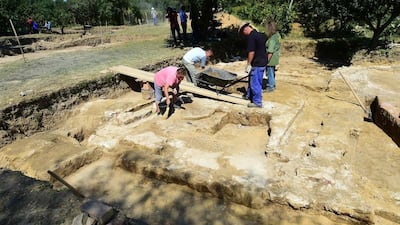Szigetvar, Hungary // The recent discovery of the tomb of Suleiman the Magnificent, considered the greatest Ottoman ruler, has raised hopes of a tourism boom in one of Hungary’s poorest areas.
From hammam baths and crumbling minarets to battle site memorials and ruins of mosques, traces of the country’s 150 years (1541 to 1699) as part of the Ottoman Empire are not hard to find in Hungary.
But many Hungarians regard those relics as part of a dark period when the country’s flourishing renaissance era was extinguished.
As a result, few of the Ottoman monuments have so far been promoted by the Hungarian authorities. But Suleiman’s case could change all that.
Experts confirmed in July that excavations begun two years ago in the struggling town of Szigetvar, close to the Croatian border, had revealed the tomb of the 16th-century ruler.
Suleiman died aged 71 on September 7, 1566, during an epic battle with the mainly Croatian defenders of Szigetvar castle. The battle depleted his forces who were hoping to quickly advance on Vienna, the capital of the Habsburg Empire.
Tomorrow, government officials from Hungary, Croatia and Turkey will join thousands of visitors to Szigetvar to commemorate the 450th anniversary of the siege.
“This town is dying. Young people are leaving or have already left for Germany or London, but Suleiman can bring in jobs, income and tourists,” said Dr Norbert Pap, head of the team of researchers who uncovered the tomb.
“Szigetvar may be on the periphery now but 450 years ago it was on the main street of European history,” said Dr Pap, a geographer and historian at the nearby University of Pecs.
Born in 1494, Suleiman, whose reign from 1520 to 1566 was the longest of any sultan, greatly expanded the Ottoman Empire, annexing large swaths of the Balkans, the Middle East and North Africa.
Taken ill before his final battle, Suleiman was found dead in his imperial camp – an hour’s walk east of the castle, according to contemporary accounts.
While his body was laid to rest in Istanbul, his heart and other internal organs were buried at the site of his death. Later a tomb was built over the site.
Around the tomb grew the town of Turbek, the only settlement that the Ottomans built from scratch during their reign in Hungary.
At the end of the 17th century, however, the town and the tomb were wiped off the map by the Habsburgs. That is until 2012, when Dr Pap secured funding from Turkey to use technology to try to find them.
A few days before Christmas 2014, a geophysics survey of a site nestled beneath vineyards and orchards 4 kilometres to the east of Szigetvar castle returned results that set Dr Pap’s pulse racing.
“It showed the presence of buildings, just under the grass, matching positions on the medieval maps of Turbek, and all of them pointing very precisely towards Mecca,” he said.
Excavations uncovered the remains of Turbek – the walls of a mosque, a tomb, dervish monastery cloisters, as well as a wealth of silver coins and clothing fragments, pottery, glass and metal.
As the evidence became overwhelming by July this year experts in Turkey were also convinced.
“Finally we could say for certain that we had found Suleiman’s tomb,” Dr Pap said.
Szigetvar, with a population of 10,000, has few hotels, but Dr Pap is convinced of the town’s potential for tourism.
The only other Ottoman sultan to die outside the empire’s centres of Istanbul and Bursa – Sultan Murad, killed in the 1389 battle of Kosovo Polje – annually attracts several thousand tourists to his tomb in Kosovo.
“Suleiman is a national cultural icon in Turkey, and as Szigetvar is easier to get to from western Europe and Turkey than Kosovo, there is a very good chance that Turkish tourists will come to visit the tomb,” Dr Pap said.
Szigetvar’s mayor, Peter Vass, said he hoped the number of visitors to Szigetvar would double from the current 25,000 a year.
The municipality has already allocated a site for the construction of higher-end hotels close to the castle.
As Dr Pap’s team continues to dig for the rest of Turbek, including a military barracks and the town’s walls, as well as Suleiman’s heart – according to legend buried in a golden urn. Five Turkish descendants of Ottoman princesses will give DNA samples next week in Szigetvar for comparison with samples from the tomb area.
“Hungary and Turkey have much in common, a shared cultural heritage,” said Turkey’s ambassador in Budapest, Sakir Fakili. “Many Turks can afford to travel, so why not to Szigetvar?”
* Agence France-Presse

